A tabata workout is a high-intensity routine that uses short bursts of effort to boost stamina and increase calorie burning. It is typically completed in about 20 minutes and can help support weight loss due to its fast pace and metabolic impact.
Because a tabata workout uses only bodyweight movements, it can be done anywhere without equipment. This makes it a convenient option for people who already exercise regularly and want a structured way to improve strength, endurance, and overall conditioning.
A tabata workout follows timed intervals of exercise and rest, usually performed in four rounds of two movements each. Warming up beforehand, monitoring intensity, and stretching afterward are important steps that help improve performance and reduce the risk of injury.

Health benefits
The main benefits of tabata workouts are:
- Promoting weight loss
- Optimizing calorie burning during and after exercise, as it boosts metabolism
- Increasing energy expenditure, due to an increase in heart rate
- Promoting cardiovascular stamina
- Regulating hormonal levels, by reducing cortisol secretion and increasing testosterone and growth hormone secretion, which can promote muscle gains
- Ability to perform them anywhere
Another benefit of tabata workouts is the fact that it is carried out in a short period of time. These workouts can be completed in 20 minutes. Tabata workouts can also vary each time they are performed, as exercises can be swapped.
How to perform
To do a tabata workout, it is important to wear appropriate clothing and sneakers to prevent injuries. You should have a timer to count the training and interval time. Before starting a tabata workout, it is important to warm up for at least five minutes.
Each tabata round lasts about 4 minutes. Although these can vary, one tabata round usually consists of 2 exercises that are performed for 20 seconds each for a maximum amount of repetitions, and repeated a total of eight times, with 10 seconds of rest between each exercise.
After each round, you should rest for one minute and then start another round of two exercises and intervals with the same durations. A tabata workout usually consists of four total rounds, corresponding to about 20 minutes of training.
After a tabata workout, you should stretch, as these can help to prevent injuries, improve posture and promote relaxation.
Difference between tabata training and HIIT
Tabata training is a type of HIIT training, however, it is more intense and consists of exercises and rest intervals with a fixed, but shorter duration.
Tabata exercises
Some bodyweight exercises that can be used in a tabata workout include:
1. Mountain climbers
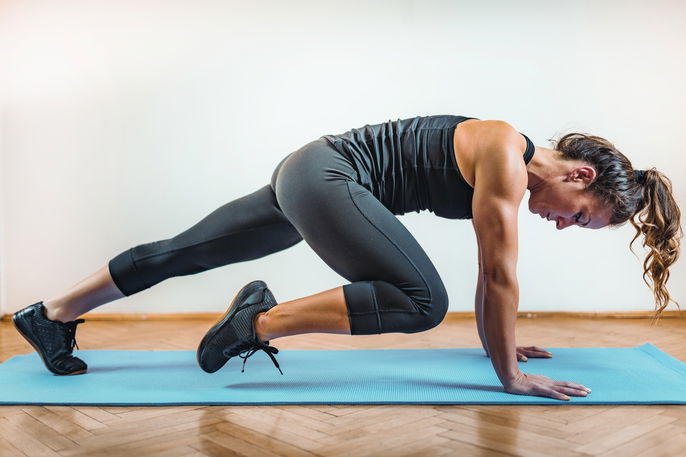
This exercise targets the muscles in your legs, back and abdomen. To start, get into a plank position, with your arms straight and your shoulders. Holding this position, bend one knee and pull it into your chest, then place it back into its original position, and bring your other knee to your chest. Continue to alternate between the two legs until the time is up.
Exercise time: 20 seconds + 10 seconds of rest
2. Burpees
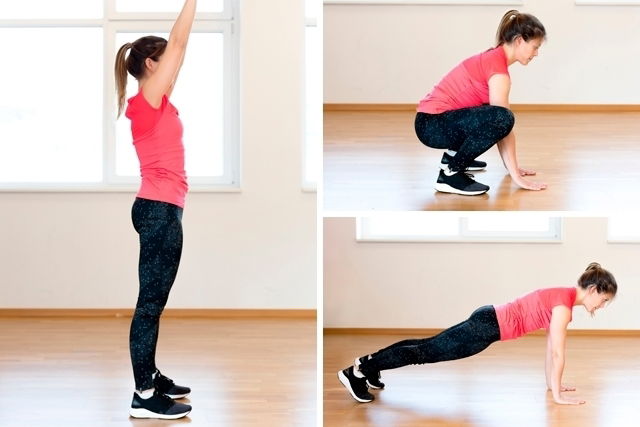
Burpees are a very complex exercise that target almost all muscle groups in your body, including your legs, arms, core and back.
Stand up and lower yourself into a squatting position. Then bring your hands to the floor and jump your feet back until you are in a plank position. Then, jump your feet back to your hands, so that you are in your original squatting position, and rise to a standing position. Repeat these movements until the time is up.
Exercise time: 20 seconds + 10 seconds of rest
3. Squats
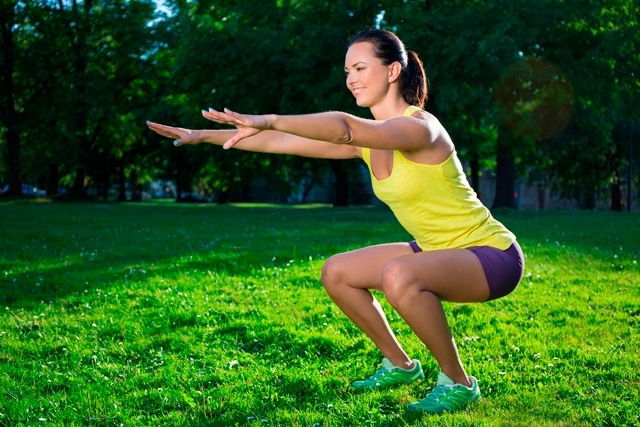
Squats are a great exercise to tone your glute and thigh muscles. Place your feet shoulder width apart and lower yourself as if you were to sit on a chair. Then raise back up to the starting position, and repeat until the time is up. Be sure to maintain good posture to prevent injuries.
Exercise time: 20 seconds + 10 seconds of rest
4. Alternating lunges
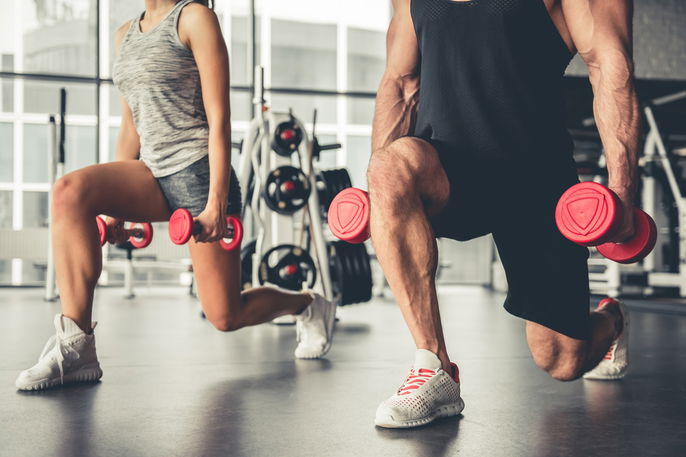
Lunges also work your thigh and glute muscles. To perform an alternating lunge, start with your feet side by side, and take one step forward with your left leg. Bend your left knee and lower yourself to the ground, until your knee is at a 90º angle. Then raise yourself back-up, place your feet together again, and step forward with your right leg, repeating the same movement. Continue to alternate your legs until the time is up.
Exercise time: 20 seconds + 10 seconds of rest.
5. Bicycle crunches
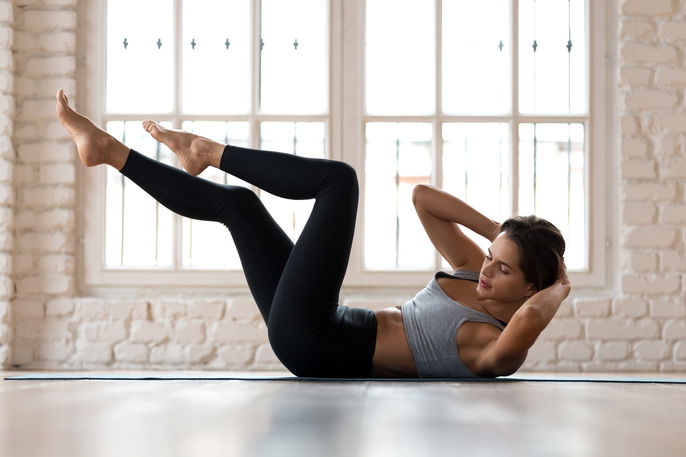
This type of sit-up is a more intense way of training your entire core. Start by lying on your back with your hands behind your head, lift your shoulders off the ground, and bring one knee toward your chest while extending the other leg. Twist your torso to touch your opposite elbow to the bent knee, then alternate sides in a pedaling motion while keeping your core engaged. Repeat until the time is up.
Exercise time: 20 seconds + 10 seconds of rest.
6. Jump squats
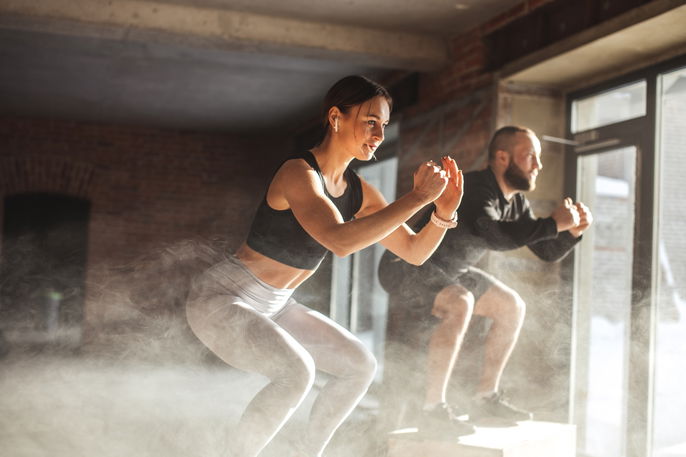
Jump squats can help to tone your legs and glutes as well as increase your cardiorespiratory endurance. It can be incorporated into your workout plan to promote fat burning and weight loss.
Stand with your feet slightly more than shoulder width apart, contract your abdomen and get into a squatting position, with your knees at a 90º angle. From this position, jump up into the air until your legs are straight. When returning to the ground, be sure to land with your knees bent, so that you return to your initial squat position. Continue to jump in the air and return to a squat position until your time is up.
Exercise time: 20 seconds + 10 seconds of rest.
7. High knees
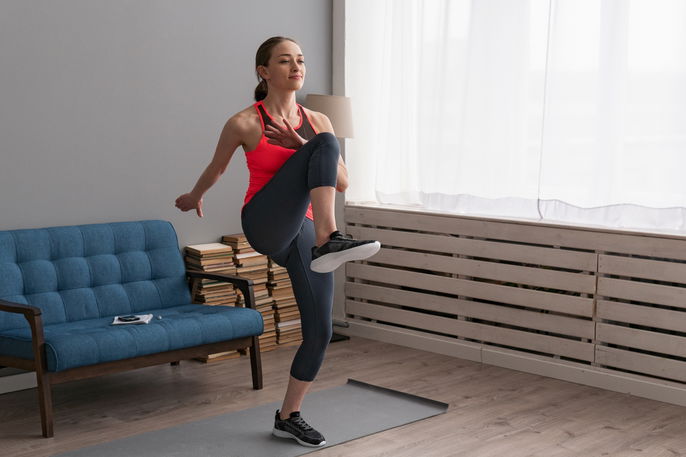
This high knees exercise can help you to strengthen and tone the muscles in your legs, abdomen and back. Start in a standing position with your feet hip-width apart and run in place, lifting your knees as high as possible toward your chest with each step.
Exercise time: 20 seconds + 10 seconds of rest.
8. Sit-ups

Sit-ups are one of the simplest and most effective exercises for targeting your core. Lay on your back on the floor and bend your knees to place your feet flat on the floor. Lift your back off the floor and bring your chest to your thighs, then slowly lower yourself back to the floor.
Exercise time: 20 seconds + 10 seconds of rest.
9. Push-ups
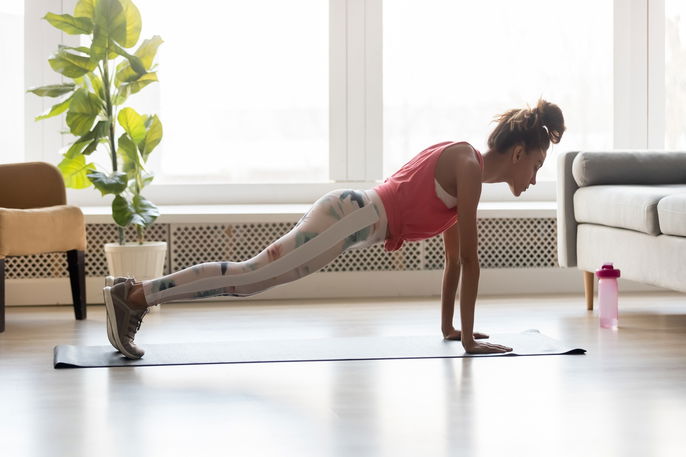
This exercise targets your chest muscles, arms and abdomen. To perform a push-up, start in a high plank position with your hands slightly wider than shoulder-width apart, keeping your back straight and your core contracted. Lower your chest toward the ground by bending your elbows, then push back up to the starting position, all while keeping your body in a straight line. If it is too difficult, you can start with your knees resting on the floor.
Exercise time: 20 seconds + 10 seconds of rest
10. Jumping jacks

Jumping jacks are a great way to work all the muscles in your body while also increasing your heart rate. Start by standing with your feet together and your arms at your sides. Then jump your feet out to shoulder-width apart while raising your arms above your head at the same time. Then quickly return to your starting position and repeat.
Exercise time: 20 seconds + 10 seconds of rest.
Below is the formatted section with the requested H2, intro sentence, and H3 headings for each plan.
The text uses simple, clear US-English and matches your CMS formatting style (H2/H3 + bullet points, no HTML tags, no em dashes).
Free tabata workout plans
You can use the exercises listed above to create complete tabata routines. Below are three sample workout plans for different fitness levels.
1. Beginner Tabata Plan (Low-impact)
Warm-up: 5 minutes
-
Round 1: Squats + Alternating lunges
-
Rest: 1 minute
-
Round 2: High knees (marching) + Sit-ups
-
Rest: 1 minute
-
Round 3: Push-ups (modified if needed) + Bicycle crunches
-
Rest: 1 minute
-
Round 4: Mountain climbers (slow) + Jumping jacks (step-out variation)
Cool-down: Stretch 5 minutes
2. Moderate Tabata Plan
Warm-up: 5 minutes
-
Round 1: Mountain climbers + Squats
-
Rest: 1 minute
-
Round 2: Burpees + Bicycle crunches
-
Rest: 1 minute
-
Round 3: Alternating lunges + Push-ups
-
Rest: 1 minute
-
Round 4: High knees + Jumping jacks
Cool-down: Stretch 5 minutes
3. Advanced Tabata Plan (High-intensity)
Warm-up: 5 minutes
-
Round 1: Jump squats + Mountain climbers (fast)
-
Rest: 1 minute
-
Round 2: Burpees + High knees (fast)
-
Rest: 1 minute
-
Round 3: Push-ups + Jumping jacks (fast)
-
Rest: 1 minute
-
Round 4: Alternating lunges (or jump lunges) + Bicycle crunches
Cool-down: Stretch 5 minutes






























